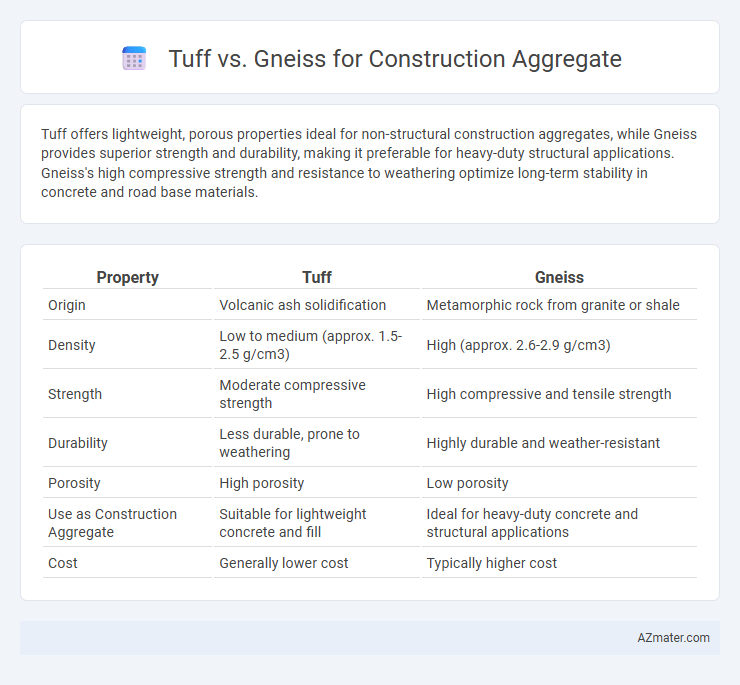Tuff offers lightweight, porous properties ideal for non-structural construction aggregates, while Gneiss provides superior strength and durability, making it preferable for heavy-duty structural applications. Gneiss's high compressive strength and resistance to weathering optimize long-term stability in concrete and road base materials.
Table of Comparison
| Property | Tuff | Gneiss |
|---|---|---|
| Origin | Volcanic ash solidification | Metamorphic rock from granite or shale |
| Density | Low to medium (approx. 1.5-2.5 g/cm3) | High (approx. 2.6-2.9 g/cm3) |
| Strength | Moderate compressive strength | High compressive and tensile strength |
| Durability | Less durable, prone to weathering | Highly durable and weather-resistant |
| Porosity | High porosity | Low porosity |
| Use as Construction Aggregate | Suitable for lightweight concrete and fill | Ideal for heavy-duty concrete and structural applications |
| Cost | Generally lower cost | Typically higher cost |
Introduction to Tuff and Gneiss as Construction Aggregates
Tuff, a volcanic rock composed of compacted ash and fragments, offers lightweight properties and moderate strength, making it suitable for specific aggregate applications such as landscaping and decorative concrete. Gneiss, a high-grade metamorphic rock with a foliated texture and high compressive strength, is valued for its durability and resistance to weathering in heavy-duty construction aggregates like road base and concrete mix. Both materials provide distinct advantages depending on structural requirements and environmental conditions in construction projects.
Geological Formation and Composition
Tuff is a volcanic rock formed from consolidated volcanic ash, primarily composed of fine-grained volcanic glass and fragments of minerals like feldspar and quartz, making it relatively lightweight and porous. Gneiss, a high-grade metamorphic rock, originates from the intense heat and pressure reworking of igneous or sedimentary rocks and is characterized by its coarse-grained texture and banded mineral composition rich in quartz, feldspar, and mica. The dense, durable nature of gneiss typically makes it more suitable for construction aggregate in load-bearing applications compared to the more brittle, less dense tuff.
Physical and Mechanical Properties
Tuff offers lightweight aggregate properties with moderate compressive strength and good thermal insulation, making it suitable for less load-intensive construction applications. Gneiss exhibits high density, exceptional compressive strength, and superior durability, providing excellent resistance to abrasion and weathering for heavy-duty construction projects. The mechanical superiority of gneiss makes it ideal for high-stress infrastructure, whereas tuff's porous nature benefits insulation and reduces structural weight.
Durability and Weather Resistance
Gneiss exhibits superior durability and weather resistance compared to tuff, making it more suitable for construction aggregate in harsh environments. Its high density and interlocking mineral grains provide excellent strength and resistance to freeze-thaw cycles, reducing degradation over time. Tuff, being a volcanic rock with higher porosity and softer texture, tends to wear down faster under weathering, limiting its long-term performance in structural applications.
Strength and Load-Bearing Capacity
Tuff, a volcanic rock, generally exhibits lower compressive strength and load-bearing capacity compared to gneiss, a high-grade metamorphic rock renowned for its robustness and durability in construction. Gneiss's interlocking mineral grains and high density provide superior resistance to mechanical stress, making it ideal for heavy-duty structural applications requiring reliable support. Tuff's porous nature limits its suitability to light-duty or non-structural aggregate uses where high strength is not critical.
Workability and Processing Requirements
Tuff exhibits lower density and softer texture compared to gneiss, resulting in easier crushing and reduced equipment wear during processing for construction aggregates. Gneiss, with its hard, foliated structure, requires more intensive crushing and screening, impacting workability but providing higher strength and durability in final aggregate products. Selecting tuff favors projects needing lightweight and easily workable materials, whereas gneiss suits applications demanding superior load-bearing capacity and abrasion resistance.
Environmental Impact and Sustainability
Tuff and gneiss differ in their environmental impact and sustainability when used as construction aggregates, with tuff being a volcanic rock characterized by lower density and often easier extraction processes, leading to reduced energy consumption during quarrying. Gneiss, a metamorphic rock, is harder and more durable but requires more intensive mining and processing, resulting in higher carbon emissions. Sustainable construction practices favor tuff for applications where lower environmental footprints are prioritized, while gneiss is chosen for structural strength despite its greater environmental impact.
Cost Comparison and Availability
Tuff, a volcanic rock, generally costs less than gneiss due to its widespread availability and easier extraction process. Gneiss, a metamorphic rock known for its durability and strength, tends to be more expensive because of limited quarry locations and higher processing requirements. Availability of tuff is greater in volcanic regions, while gneiss is commonly sourced from metamorphic zones, impacting local pricing and transportation costs for construction aggregates.
Common Construction Applications
Tuff and gneiss serve distinct roles in construction aggregate applications due to their differing physical properties. Tuff, a lightweight volcanic rock, is often used in lightweight concrete, insulation, and landscaping due to its porosity and ease of handling. Gneiss, a dense, coarse-grained metamorphic rock, is preferred for high-strength concrete, road base, and heavy-duty structural fill where durability and load-bearing capacity are critical.
Choosing the Right Aggregate: Tuff vs Gneiss
Tuff, a volcanic rock with lower density and higher porosity, often suits lightweight construction applications but may lack durability in high-load environments compared to gneiss. Gneiss, a metamorphic rock characterized by its high strength and resistance to weathering, provides superior structural stability and longevity for heavy-duty aggregates. Selecting between tuff and gneiss depends on project requirements such as load-bearing capacity, environmental exposure, and desired lifespan of the aggregate material.

Infographic: Tuff vs Gneiss for Construction Aggregate
 azmater.com
azmater.com